Honor Award
Biophones
Nicholas Glover, Student ASLA, Arizona State University
Faculty Advisor: Ken McCown, ASLA
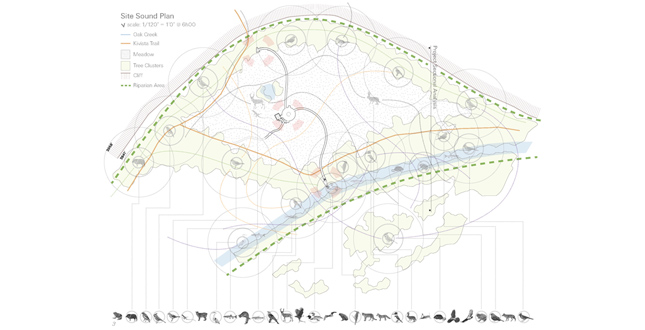
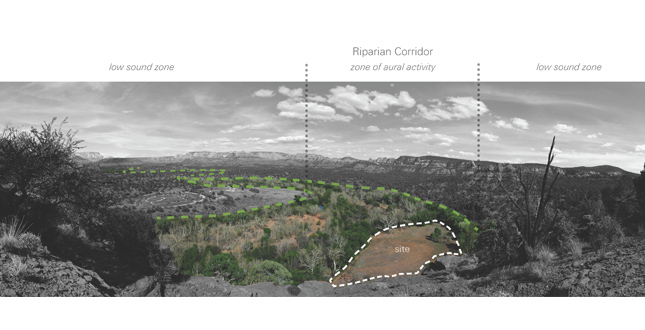 Close Me!
Close Me!The riparian corridor at Red Rock State Park, full of birds and other creatures, possesses a unique collection of sounds found no where else in the park.
Download Hi-Res ImagePhoto: Nicholas Glover
Photo 2 of 16
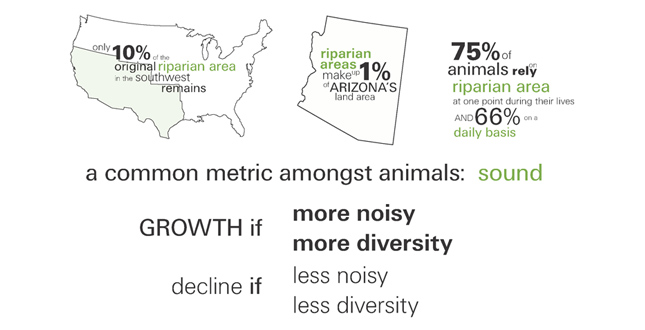 Close Me!
Close Me!Animals at Red Rock State Park rely on Oak Creek to provide them with food, water, and shelter. Since animals depend on the creek, they can be used as a measurement to evaluate the health (growth/decline) of the corridor.
Download Hi-Res ImagePhoto: Nicholas Glover
Photo 3 of 16
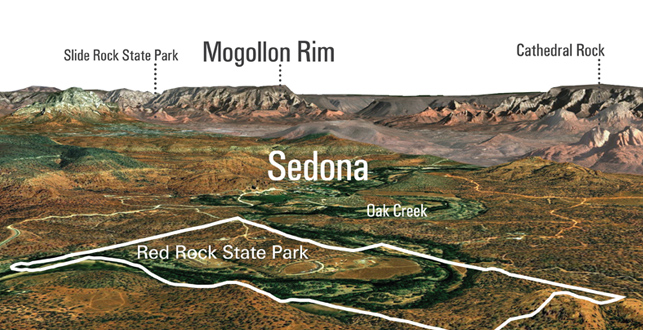 Close Me!
Close Me!Looking North East. Red Rock State Park protects only a portion of Oak Creek. Situating the project within the park will reveal potential problems upstream caused by the city and its users.
Download Hi-Res ImagePhoto: Nicholas Glover
Photo 4 of 16
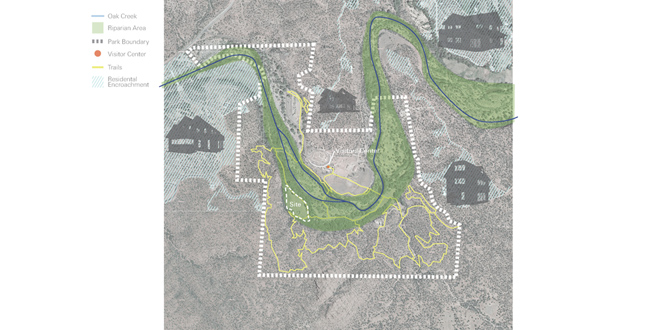 Close Me!
Close Me!Park Plan. Red Rock State Park protects the natural habitat and native inhabitants, however residential developments continue to encroach along its perimeter.
Download Hi-Res ImagePhoto: Nicholas Glover
Photo 5 of 16
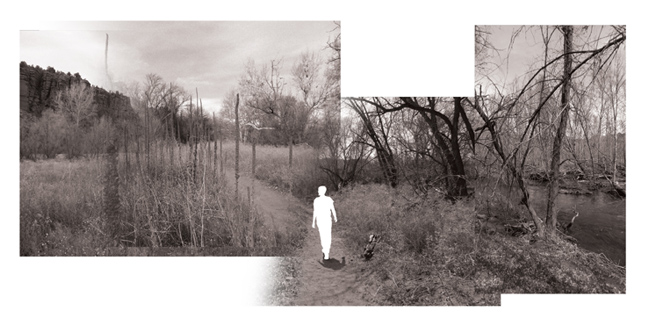 Close Me!
Close Me!Site approach. An untrained observer can become overwhelmed with the visual beauty of the park and forget to actively appreciate the equally incredible soundscape.
Download Hi-Res ImagePhoto: Nicholas Glover
Photo 6 of 16
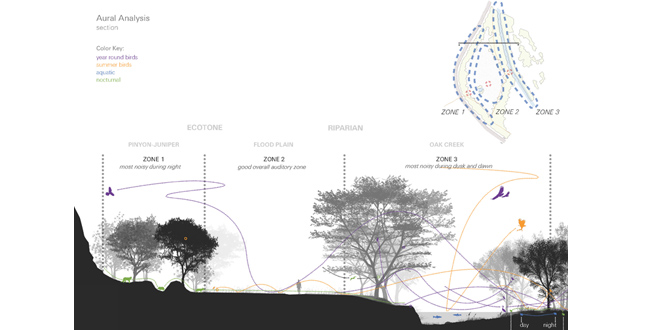 Close Me!
Close Me!Aural Analysis Section. An initial sectional site analysis revealed 3 primary sound zones active at different times of the day. A further investigation in plan determined the locations of each biophone.
Download Hi-Res ImagePhoto: Nicholas Glover
Photo 7 of 16
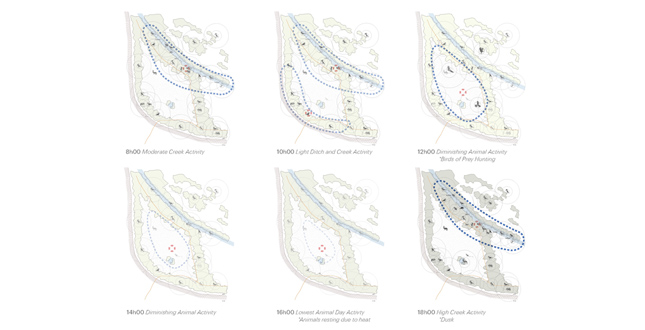
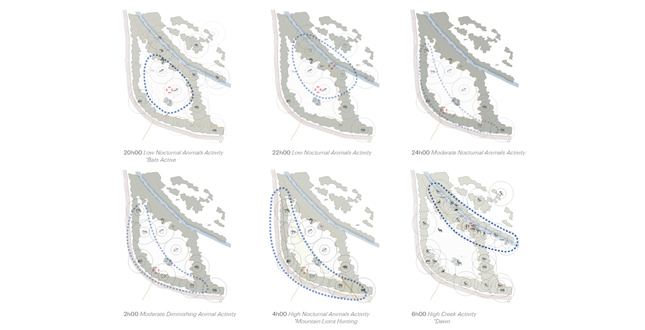 Close Me!
Close Me!The soundscape at this location is in constant flux. The location where sound is the greatest influences the placement, design, and sequence of spaces.
Download Hi-Res ImagePhoto: Nicholas Glover
Photo 9 of 16
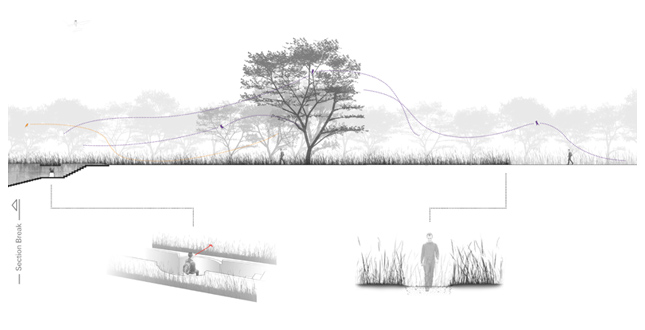 Close Me!
Close Me!Procession. A space where the observer can see and hear at ground level. Tall grasses in the meadow begin to focus the observer’s attention into the project.
Download Hi-Res ImagePhoto: Nicholas Glover
Photo 10 of 16
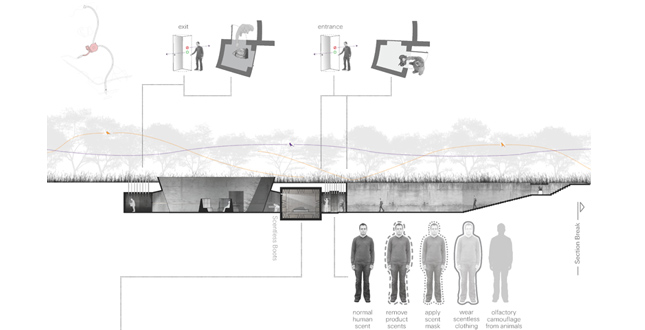 Close Me!
Close Me!Entrance to Biophones. Sensory deprivation inside an anechoic chamber results in a period of hyper sensory hearing and auditory recalibration. Animals obtain a keen sense of smell. Masking human scent will aid in the observation process by allowing animals to venture closer.
Download Hi-Res ImagePhoto: Nicholas Glover
Photo 11 of 16
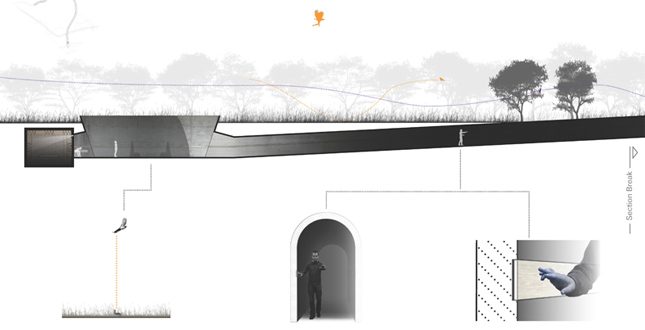 Close Me!
Close Me!Biophone Node. Birds of prey hunt when the sun is at its highest point so shadows do not interfere with visual perception. The observer experiences a gradient of sound and light when traveling between biophones. A marble inset, cold to the touch, acts as a guide through the dark tunnels.
Download Hi-Res ImagePhoto: Nicholas Glover
Photo 12 of 16
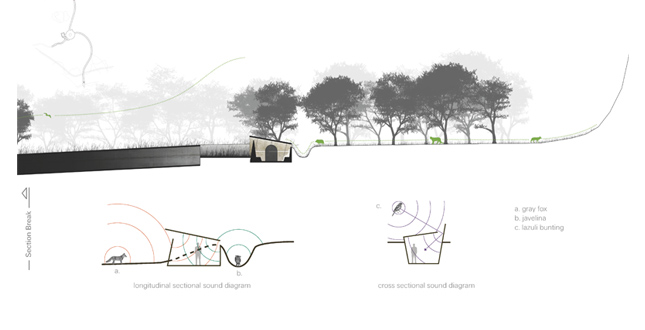 Close Me!
Close Me!South Biophone. Each biophone is visited at least twice at different times of the day. The soundscape at this biophone radically changes from the morning to night.
Download Hi-Res ImagePhoto: Nicholas Glover
Photo 13 of 16
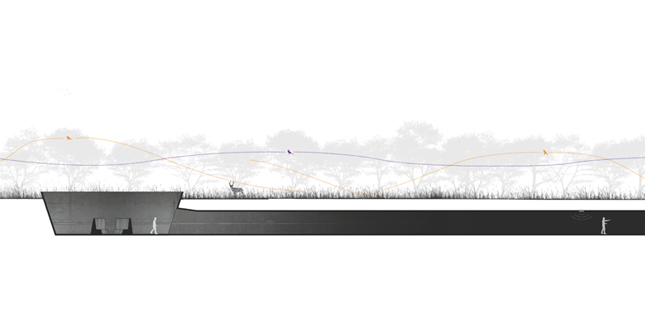 Close Me!
Close Me!Biophone Node. Day: a hydrophone, placed in the creek, captures the sounds underwater and is played through a speaker in the corridor. Night: A bat detector captures the echolocation sounds made by bats and steps the frequency down into the human hearing range.
Download Hi-Res ImagePhoto: Nicholas Glover
Photo 14 of 16
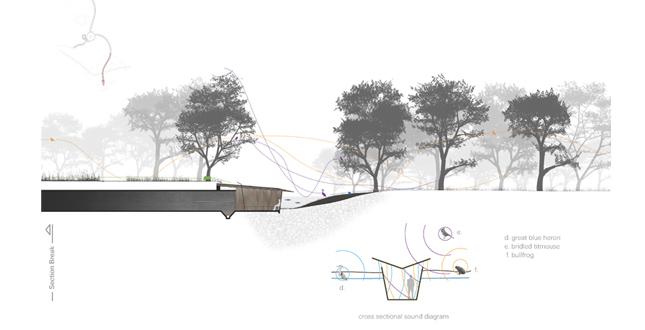 Close Me!
Close Me!North Biophone. Dawn and Dusk exhibit an emergent dynamic soundscape. At this time the daily soundscape escalates to a plethora of animals contributing to an orchestra of calls and then shifts to the evening soundscape or vice versa.
Download Hi-Res ImagePhoto: Nicholas Glover
Photo 15 of 16
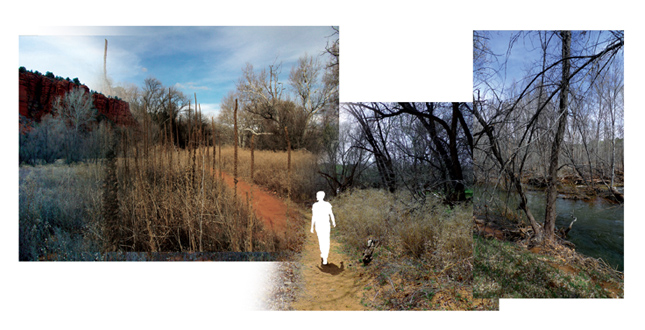 Close Me!
Close Me!Upon leaving Biophones, the observer now with a heightened sense of hearing, can better notice the subtleties of the urban and natural soundscapes, how they change over time, and how noise and sound affects our lives.
Download Hi-Res ImagePhoto: Nicholas Glover
Photo 16 of 16
Project Statement
Biophones serves as an environmental measuring device and also trains the human ear to notice the subtle nuances in our soundscapes. It connects people to the natural habitat through sound as animal calls become an indicator of environmental health. Biophones trains people to be advocates of natural soundscape awareness and preservation by teaching observers how to listen.
Project Narrative
What is a Landscape Observatory?
A landscape observatory as described by my instructor “reveal[s] a natural feature and incorporate[s] a natural process… including some capacity to observe and measure change over time in the process .” The studio calls for a design which promotes sustainability by allowing each user to experience environment change while incorporating a space to eat, sleep, and bathe. My landscape observatory explores the aspect of sound as it differentiates the unique riparian landscape from its surroundings. The animal calls within this landscape act as an indicator to the health of the riparian corridor depending on the volume and frequency of calls.
Site
Biophones is located in the Oak Creek riparian corridor at Red Rock State Park in Sedona. The meandering creek lined with sycamores, elders, and cottonwoods provides a year-round home for rich biodiversity and a safe haven for migratory birds. Aside from the 200 different aviary residents, a wide range of insects, reptiles, amphibians, rodents, and mammals use and rely on the creek daily. The plethora of biodiversity attributes to a unique concert of animal calls within the corridor. Red Rock State Park is a small 286 acre natural reserve, but faces contamination by residential encroachment along its perimeter.
Riparian Corridor
Only 10% of the natural riparian area in the Southwest remains. Residential encroachment, logging, mining, agricultural run off, etc have decreased riparian zones. In the state of Arizona, 1% of the total land area is riparian. However, 75% of animals rely on the riparian area at least once in their lives and 66% on a daily basis (Red Rock State Park). As Sedona grows in a population and popularity as a tourist destination, creek overuse and residential development alter the conditions of Oak Creek. Biophones, as a landscape observatory, measures the growth or decline of the riparian area at Red Rock State Park raising awareness of ecological health through animal calls. The sound in the landscape is recorded digitally and in the experiential memory of each observer.
Why Is Sound Important?
“Sight isolates, whereas sound incorporates; vision is directional, whereas sound is omnidirectional. The sense of sight implies exteriority, but sound creates an experience of interiority. I regard an object, but sound approaches me; the eye reaches, but the ear receives. Buildings do not react to our gaze, but they do return our sounds back to our ears. ” Juhani Pallasmaa
Biophones, using the study of biophony, applies animal calls (a commonality among most animals) as its means to measure the riparian corridor. Since animals depend on the riparian zone for energy, shelter, and their survival, they can be thought as bioindicators - the more populated and diverse the animals, the more healthy the landscape. Sound (animal calls), however, brings data to the observer instead of tediously counting animals individually and establishes a relationship between the corridor and the sounds heard. The corridor is growing if there are more animal calls heard more frequently with a greater diversity. The corridor is declining If there are fewer animal calls heard less frequently with a lower diversity. The experience of listening to the soundscape ingrains an aural awareness in each observer which cannot be taught through hearing a series of recordings. The learned awareness can be used to analyze other environments.
Biophones
Biophones presents a sequence of events to provide an experience of re-learning how to listen. A procession into the earth shields the observer from familiar visual stimuli during the learning and recalibration process. Four different biophones: Node, Central, North, and South provide different perspectives upon the sounds of life in the Oak Creek riparian corridor. Sounds of each space change drastically as the observer travels underground between biophones throughout the course of 24 hours.
Entrance Procession and into the Biophones
The experience begins as a observer approaches the site and takes a path off the main trail. The perennial grasses reach five and a half feet tall and the trail descends nine steps into the ground. A small concrete seat in the path prompts the observer to sit and listen with eyes and ears at ground level - indicative to how animals perceive the world. Time slows as elongated, shallow steps move the observer down a curved path surrounded by horizontal reinforced board formed concrete walls. Two modest doors are at the end of the descent, one with a handle and one without. The observer enters the one-way door into a bathing space to remove the manufactured scents, apply a scent mask, and put on scentless clothes. This prevents animals from identifying human presence. Animals evolved to have a keen sense of smell since they walk with their heads close to the ground. The observer’s places his or her belongings within a cabinet which is also accessible through the auxiliary washroom. The observer proceeds through another one-way door into an anechoic chamber. The silent chamber prevents exterior noise from entering. Depriving a person from noise for an extended duration results in a period of hypersensitive hearing where one can begin to discern sounds otherwise unnoticed. After three hours a light gradually illuminates the room prompting the observer to exit the room.
Biophone Node
The Node is a twelve foot deep inverted cone open to the sky to receive and focus the sounds from the riparian area. This space is a hub to access the other biophones accessed by two underground tunnels. The cone also has a sheltered outcropping provides a place to eat and an auxiliary washroom provides a toilet, sink, scent mask rinse, access to belongings, and the one-way exit from the Biophones. The anechoic chamber can be reaccessed to rest and re-heighten auditory sensitivity during afternoon and evening.
Central Biophone
The Central Biophone nestled within the Node provides a more focused space to observe the soundscape. A circular, concrete structure with benches forms a view to the sky. At noon, birds of prey can be heard soaring high in the sky. At night, bat chirps fill the meadow as they feed on insects.
Tunnels
Two underground tunnels lead to the North and South Biophones . These curving tunnels create a gradient of light and sound to heighten auditory sensitivity. A six-inch marble veneer, cold to the touch, is a guide in the dark. In the north tunnel, during the day, a speaker plays the sound from a hydrophone placed in Oak Creek to reveal the burps and grunts of fish. During the evening, the speaker plays the sounds from a bat detector placed in the meadow which steps the high frequency of bat’s echolocation chirps down to an audible human frequency. The south tunnel is silent except for the echoes imposed by the observer.
South Biophone
The South Biophone is a small concrete structure located near an existing engineered drainage ditch. Shaped like a megaphone, three openings facilitate sound entering from the ditch, the meadow, and the trees above. The observer can hear javelinas and other mammals walking through the ditch during the day. Mule deer visit the watering hole in the meadow during the cooler hours of the day and birds sing as they fly from the tree tops. During the evening, the soundscape changes to include coyotes, foxes, ring tailed cats, bobcats, and mountain lions.
North Biophone
The North Biophone is a small steel structure located on the side of the creek. Water hits the steel shell around the space creating a soft sound which changes seasonally depending on creek height and flow. The creek is most alive during dawn and dusk when the birds, amphibians, fish, reptiles, rodents, and mammals come out to feed. This space is the most pleasurable during the emergence into the day and the orchestra of all the animals which fades at dusk.
“The centering action of sound affects man’s sense of cosmos,”Juhani Pallasmaa
Biophones provides a means to recalibrate an observer’s sensitivity to environmental soundscapes and to factually measure the growth/decline of the vital, fragile riparian corridor. In a world full of excessive noise burdening our quotidian urban lives and deteriorating our natural habitats, Biophones trains advocates of natural soundscape preservation by teaching observers how to listen. With the specific skill-set of analyzing an environment through listening, new information can be inferred from everyday situations to make informed daily decisions to lessen the impact of excessive noise.
Additional Project Credits
Jeffery Clancy
Worked in collaboration on plan during site analysis.
Google Earth Imagery
Google.com
Ken McCown
“ASU Landscape Observatories Integrals Syllabus”
Brian Miller
Work in collaboration on animal cut-outs during site analysis.
Juhani Pallasmaa
“The Eyes of the Skin — Architecture and the Senses.” Wiley Academy
Red Rock State Park
Visitor Center Information Handouts and Information boards, Sedona, Arizona
acousticecology.org
Gathered biophony information from this site.
allaboutbirds.com.
Gathered animal information from this site.
animaldiversity.org
Gather animal information from this site.





